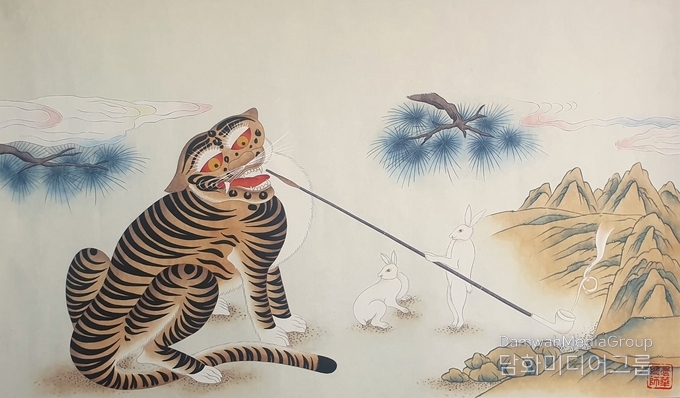By Jon Lee | Folk painting is a composite art, and the fact that all Korean crafts always have folk-like paintings on them allows us to speculate on the function of Korean folk paintings.
In other words, folk paintings are not just decorations on celadon, white porcelain, cabinets, pencil cases, and many other crafts, but they are an important folk painting element without which a work of art would be lifeless.

Folk paintings, which are the most obvious manifestation of the Korean people's sense of aesthetics and sculpture, have been one of the most important elements of Korean architecture as an ancient comprehensive art, not only decorating houses, whether palaces or temples, but also creating houses.
Inside the house, inside the gate, and in the courtyard, paintings and writing were the medium and lifeblood that united buildings and people within a dwelling.
For example, paintings were often used to illustrate architecture and convey cultural and religious meanings, as seen in the hunting paintings on Goguryeo tombs or the murals at Hwangnyongsa Temple.
Also, the use of Korean colored dancheong (traditional multicolored paintwork on wooden buildings), which is used for pavilions, is an example of continuing this tradition. The use of folk paintings not only in the decoration of buildings, but also in their interiors and exteriors, demonstrates that Korean architecture is both aesthetic and artistic.
However, most Korean folk paintings are believed to have been created in the 19th century. In particular, many folk paintings were produced during the period from the end of the Joseon Dynasty to the present day.
During this period, paintings and picture books were popularized among the general public, and the production and possession of folk paintings were actively practiced. Especially in the late 19th and early 20th centuries, many folk paintings were produced in Seoul, Ganghwa Island, and Hamgyong Island.
These folk paintings covered a wide range of subjects, including scenes, animal paintings, and folk paintings, and often contained educational and entertaining content.
However, since most of the folk paintings produced during this period were drawn on paper, many of them have been poorly preserved or lost over the years.
Therefore, most of the folk paintings we have today are from the late 19th and early 20th centuries. These folk paintings are an important source for understanding and studying Korean folk art and culture. These works play an important role in understanding the history and development of Korean folk paintings and contribute to preserving the diversity and character of our culture.
There is also a picture of a rabbit lighting a tiger's cigarette. We all know that it's not just a funny picture, but in myths and legends, rabbits not only live in the dragon palace, but also in the moon palace, where they dig for herbs and beat in a mortar.
In addition, tigers are usually represented as mountain gods, and in texts such as the Sanhaegyeong, they appear in the form of the Seowangmo. Folk paintings allow for many different interpretations. The interpretation of spiritual symbolism is an interesting and deep topic. Fire has many different meanings in many cultures, and examining it through myths and legends can give us insight into human emotions and ideas.
Analyzing and interpreting folk paintings and legends is therefore one of the most important topics in anthropology and cultural studies. “A rabbit lights a cigarette for a smoking tiger” is one of the most famous stories in Korean folk paintings. It depicts a tiger and a rabbit together, often with the tiger smoking a cigarette.
First of all, it shows the opposing nature of the two animals, the tiger and the rabbit. The tiger is a strong and dangerous animal, traditionally perceived as a threat to us. The rabbit, on the other hand, is a small and weak animal, usually depicted as prey for the tiger.
In this painting, however, the rabbit is surprisingly shown lighting a cigarette for the tiger. This is an unusual situation that reverses traditional roles, and it has a lesson to teach us. It can convey the message that the weak help the strong, or that help can come in forms we don't expect.
It also makes us think about our humanity by paradoxically dealing with situations we encounter in our daily lives. This picture has a deep meaning in Korean folk paiontings, and while there are many different interpretations and stories, it is characterized by the theme of unexpected help.
Korean folk paintings have long reflected the sentiments and culture of our people, and as a result, they have played a large role in shaping the beauty and unique artistry of Korean architecture.













